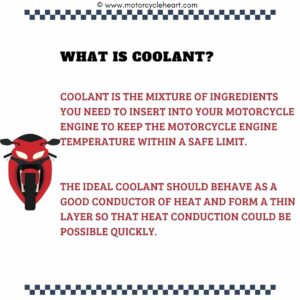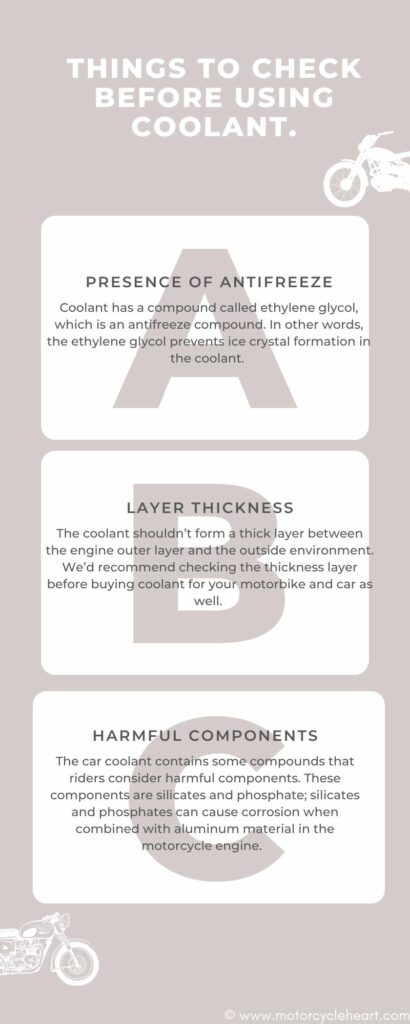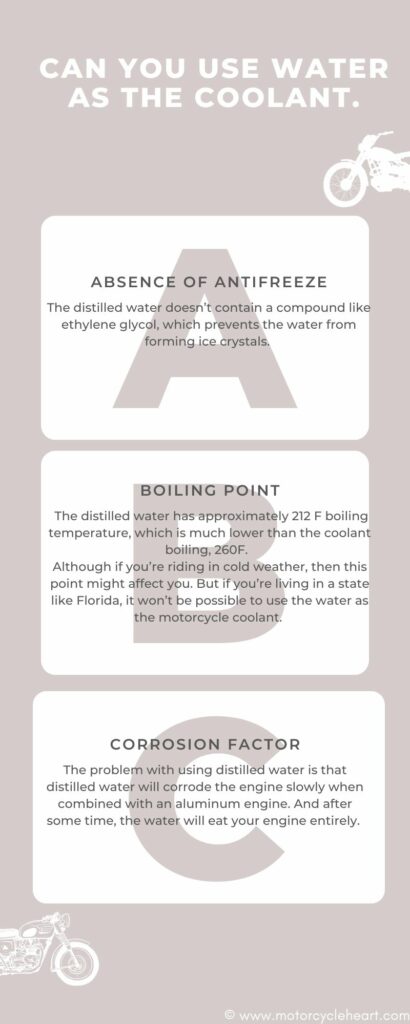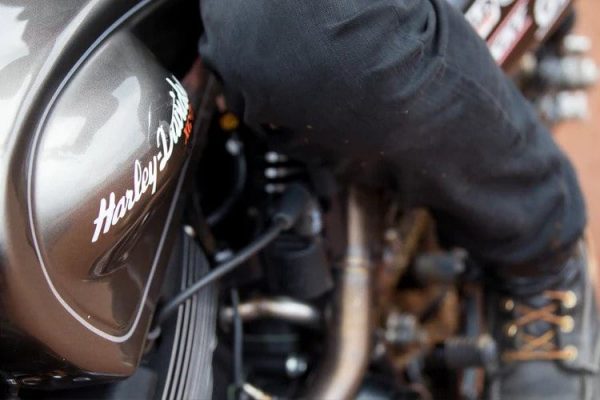Low oil and high RPM are some causes why your motorcycle engine overheats. And to tackle this overheat, coolant is essential. Now the question is, is motorcycle coolant the same as car coolant?
Yes, motorcycle coolant is the same as car coolant. However, many motorcycle coolant manufacturers made their coolant different from the car coolant.
We’d recommend checking the ingredients of the coolant before inserting the coolant in the motorcycle.
So, what ingredients should you see? And can you use the water as a natural coolant? Worry not! In this article, we’ve covered all answers to your questions.
What is Coolant:
Before understanding the ingredients of coolant, you must first understand what coolant is?
Coolant is the mixture of ingredients you need to insert into your motorcycle engine to keep the motorcycle engine temperature within a safe limit.
The ideal coolant should behave as a good conductor of heat and form a thin layer so that heat conduction could be possible quickly.

Is Motorcycle Coolant the Same as Car Coolant?
Yes, the motorcycle coolant is the same as car coolant; even you can use car coolant in the motorcycle. But some manufacturers made their coolant specifically for one type of vehicle.
We always recommend checking the ingredients list before making any final decision. And if you don’t know what ingredients make the coolant suitable for both vehicles, then it’s better to use coolant explicitly made for your motorbike.
Things to Check Before Using Coolant:
There are many things that you need to check before choosing the coolant for your vehicle. However, here we’re going to discuss only the best three of them.
| Things to Check Before Using Coolant: |
| Presence of antifreeze components. |
| Layer thickness. |
| Presence of harmful components. |
Presence of Antifreeze:
Coolant has a compound called ethylene glycol, which is an antifreeze compound. In other words, the ethylene glycol prevents ice crystal formation in the coolant.
Coolant contains ethylene glycol as antifreeze is considered safe for cars and motorbikes as well.
Layer Thickness:
The coolant shouldn’t form a thick layer between the engine outer layer and the outside environment. We’d recommend checking the thickness layer before buying coolant for your motorbike and car as well.
Harmful Components:
The car coolant contains some compounds that motorbike riders consider as harmful. These components are silicates and phosphate; silicates and phosphates can cause corrosion when combined with aluminum material in the motorcycle engine.
Even worse, these components are bad for seals and aren’t environmentally friendly.
So above are some components which you need to consider while choosing the best coolant for your motorcycle. Please always remember that inserting the wrong coolant in your motorbike might seize your engine permanently because of overheating.
If you’re a non-techy person who doesn’t have enough knowledge about ingredients, then we’d recommend choosing a motorcycle-specific coolant. Doing this will save your time and give you peace of mind to use the suitable coolant.

Can You Use Water as the Coolant:
Some riders believe that they can use distilled water as the coolant. After all, it’s way cheaper than coolant and can cool the engine more effectively than the coolant.
But here’s the problem using the water as the coolant:
| Problem with using water as the motorcycle coolants. Absence of antifreeze components. Lower boiling point. Corrosion factor. |
Absence of Antifreeze:
The distilled water doesn’t contain a compound like ethylene glycol, which prevents ice crystals formation.
It means in the cold weather specifically around zero degree celsius, the water can form ice crystals which may seize the engine. Although the chances are sporadic, you still can’t afford to miss this fact.
Boiling Point:
The distilled water has approximately 212 F boiling temperature, which is much lower than the coolant boiling, 260F. Although if you’re riding in cold weather, then this point might not affect you. But if you’re living in a state like Florida, it won’t be possible to use the water as the motorcycle coolant.
Corrosion Factor:
The problem with using distilled water is that it will corrode the engine slowly when combined with an aluminum parts in the engine. And after some time, the water will eat your engine entirely.
So to promote the longevity of your motorcycle engine, we won’t recommend using water for coolant.
If you want to boost the motorcycle’s overall health by increasing the engine’s age, we won’t recommend settling for a cheaper way to cool the engine. Intead try your best to buy expensive motorcycle coolants as they are best for your motorcycle and help promote the motorbike’s overall health.

How to Choose the Best Coolant:
In this section, you’re going to learn how to differentiate different types of coolants.
You’re going to find two types of coolant; one is with ethylene glycol and the second with propyl glycol. But which one should you choose?
Most professional riders consider propylene glycol coolant as the most efficient and best for their motorbikes. However, ethylene glycol is also the best and efficient option for your motorcycle.
Propyl glycol has high specific heat, while ethylene glycol comes with superior heat efficiency because of low viscosity. It means you’ll need more ethylene glycol coolant to transfer the same amount of heat energy as propylene glycol coolant.
If you’re a professional rider who pushes your motorbike to a different extent, then we’d recommend using Propylene glycol coolant. But if you’re a regular or casual rider, then ethylene glycol coolant is more than enough for you.
The second difference between the two is that ethylene glycol is more toxic for humans than propylene glycol. It means you can use the propylene glycol even at home, but with ethylene glycol, you couldn’t use it in your home because of its high toxicity.
And please don’t even think about mixing two coolants; luckily, both liquids come in two different colors.
As we mentioned above, please see the ingredients of the coolant before inserting it into your motorbike as compounds like silicate and phosphates can contribute to the formation of an insulation layer which is again not good for your motorbike.
How Good is to Change the Coolant?
If you’re planning to change the coolant or shifting one coolant to another, then you should know that you can’t mix one coolant with another. It means you’ve to flush out all the coolant from your motorcycle before inserting another coolant.
Let us tell you that this process is not as easy and isn’t hassle-free. Additionally, you can’t afford to commit a single mistake while shifting one coolant to another; otherwise, your engine can be seized anytime.
We always recommend sticking with one type of coolant or hiring a professional technician to do this work.
What are Different Types of Coolant:
Generally, you’ll find two types of coolant in the market. The first is a water-based coolant, and the second is a water-free coolant.
Water-Based Coolant:
As the name suggests, this coolant comes with water in it, or you’ve to put the water in the coolant by yourself in a 50:50 ratio.
The best thing about this coolant is that it’s cost-effective and works well for a casual motorcycle rider. However, this type of coolant also comes with its disadvantages.
The most significant disadvantage is the lower boiling point because of the water in it. It means this type of coolant can’t cool the motorcycle engine effectively. And this is the reason why professional riders don’t like this coolant.
The other most significant disadvantage of this type of coolant is the corrosion problem. Water-based coolant has water in it, which corrodes your motorcycle engine slowly and will eat your motorcycle from inside in no time.
Water Free Coolant:
As the name suggests, a water-free coolant doesn’t come with water in it. Water-free coolant is considered best for extreme conditions in which the motorbike demands more cooling in a short time.
The best thing about this type of coolant is that it doesn’t corrode the engine and comes with a high boiling point, makings coolant the most effective.
The only disadvantage of a water-free coolant is that it’s more expensive than a water-based coolant. However, the water-free coolant will last for many days, which means you’ll save more money; think of this as an investment.
Frequently Asked Questions:
Can you use car coolant for motorcycle too?
Yes you can use car coolant for your motorcycle too, but some manufacturers made their coolant specifically for one type of vehicle.
Is it important to read ingredients of coolant before using it?
Yes, it’s important to read ingredients list of coolant before using it. It’s because some coolant contains compounds like silicates and phosphates which can seize your motorcycle engine permanently.
Is thick layer of coolants is a big issue?
yes, it’s a big issue and the coolant shouldn’t form a thick layer between the engine outer layer and the outside environment. And that’s why we’d recommend checking the thickness layer before buying coolant for your motorbike and car as well.
What is water-based coolants?
As the name suggests, this coolant comes with water in it, or you’ve to put the water in the coolant by yourself in a 50:50 ratio.
The best thing about this coolant is that it’s cost-effective and works well for a casual motorcycle rider. However, this type of coolant also comes with its disadvantages.
When and why water is used as coolants?
Water absorbs a lot of thermal energy and releases it reasonably quickly. It is easy to circulate so you can pump it through a heat exchanger easily. However, the distilled water has approximately 212 F boiling temperature, which is much lower than the coolant boiling, 260F.
Although if you’re riding in cold weather, then this point might affect you. But if you’re living in a state like Florida, it won’t be possible to use the water as the motorcycle coolant.
Final Verdict:
Is motorcycle coolant the same as car coolant? Yes, motorcycle coolant is the same as car coolant. However, many motorcycle coolant manufacturers made their coolant different from the car coolant.
Factors like the presence of anti-freezing compounds, absence of harmful components and layer thickness are some factors you always need to consider while choosing the best coolant.


